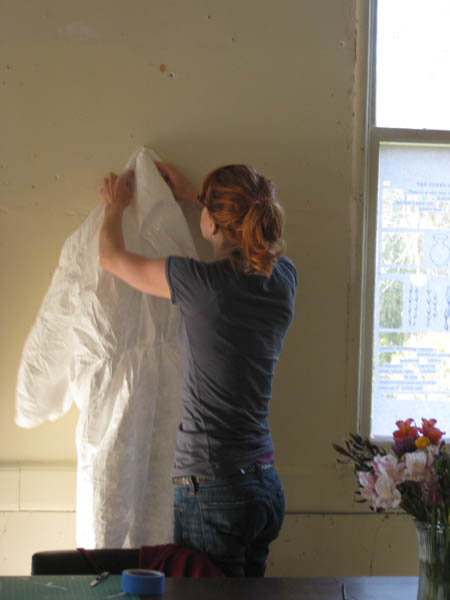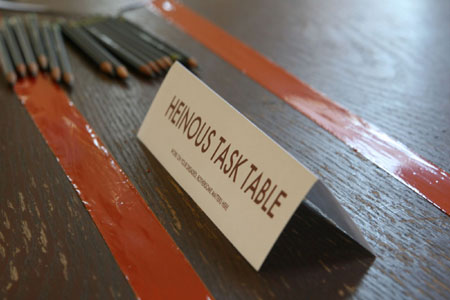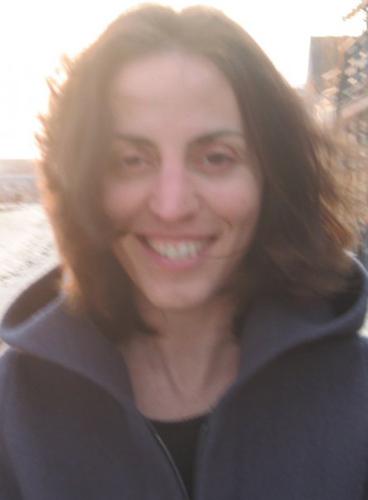Imagine you are standing at the base of a steep hill. Okay, now picture a trusted friend standing with you there at the base of that incline. According to a 2007 study entitled “Social Support and the Perception of Geographical Slant,” in the company of that friend, you are likely to rate the slant of that hill rising before you as gentler than you would standing there alone. We can easily make the leap from the geographical slope to the pile of student papers or stack of bills angling for our attention. The Heinous Task Table, a participatory public project I started in 2007, operates on the premise we see at work in the study above – that the sheer presence of a friend can help us see something difficult as more approachable.
As I wrote in Part I, The Heinous Task Table generates a field of morale in which participants muster the wherewithal to turn toward tasks they’ve been avoiding. It’s a kind of study hall for adults. People don’t necessarily work directly on each other’s projects (though this does happen); rather, they provide “a psychic anchor,” as one participant phrased it, for each other, working in tandem on their own projects.
Here in Part II, we’ll explore the nature of these tasks further, and we’ll consider how we curate our energy in relation to these tasks and how social interaction plays a crucial role in helping us find the heart to do these things so that our energy is more flexible and available.
Behold the Reimbursement Claim form that has been awaiting my attention for four weeks. Photo credit: Genine Lentine.
The horror. The horror. Cast your eyes, if you dare, over the pulse-stopping rows of boxes! Is your heart not stricken with revulsion as you gaze upon the words “Benefit Code?” Does the prospect of reconstructing the “Dates of Service” not chill you in a manner not unlike looking into your own grave? Completing such a form feels as if it must be performed outside the channel of sociability. Got a flight to cancel or change? That’s a solitary pursuit. Don’t plague your friend with it except, perhaps, for a sporty round of ritual complaining a process that acts more as a kind of mutual affirmation of misery in which laments are traded in a vortex of one-downsmanship, more invested in maintaining – or even bolstering – the perceived burden, rather than dismantling it.
The Heinous Task Table looks upon your awkward hesitation, your conviction that you will never get the thing done, and says, Bring It. No task is too trivial or too thorny to be borne in its field. The Table turns its curious and benevolent eye on all who come unto it. It essentially provides a container, a steady place for brooking uncertainty.
Why does The Table work? I think it has to do with the wish to be part of the pack. At its heart, it’s a variation on the psychoanalyst D.W. Winnicott’s concept of “the holding environment,” the stable space from which the child can experience the free flow of her being, in the balance of a parent that is neither too intrusive nor too abandoning.
When I first encountered Winnicott’s framework in Mark Epstein’s book, Going to Pieces without Falling Apart, I noticed that I was often negotiating for a similar context, whether within myself or in my circumstances, or, say, in the shape of my desk. The wish to create such a space was at the heart of this project. I asked Epstein recently for his thoughts on how Winnicott’s framework relates to the project’s collaborative context for tasks that are often done in solitude.
He commented, “Spreading the ego around the table takes down the artificial ego boundaries. By doing a group thing, you’re resurrecting a shared experience which frees people from their isolation so that spontaneous movement becomes possible. The private forlorn state is a hard state in which to be productive.”

Jane Castillo, triumphant after putting batteries in her flashlights. Headlands Center for the Arts, 2009. Photo credit: Genine Lentine.
Just naming the task is, in itself, helpful in addressing it, but Epstein points out, “It’s more than just naming the task; it’s the sharing it. Because someone else at the table allows the intention to be shared, the spotlight is no longer on the individual who is trying to do the task, which lets that person actually make a move, unhindered by her fixed definition of herself.”
We set up a notion of who we are and then “who we are” has to include the person who is able to e-mail the climate change organization whose vision we fully support to tell them we can no longer do the work we’ve been doing with them. Or maybe “meeting with the wedding cake designer,” doesn’t ring true with our sense of who we are, so these disjuncts becomes difficult to reconcile. In the presence of others, we can experience momentary relief from such ideas as “I’m a terrible correspondent” and we can slip under the radar of our own self-imposed limits perhaps even for long enough to write the letter.
So, probably one of the most fundamental strategies of the project is to treat each obstacle with neutrality, and suspend judgment. No obstacle is unworthy of attention if it’s “in the way” of what we feel is a “truer” expression of what we have to offer in the world. A student in my writing class told me, in discussing the administrative matters he feels keep him from writing, “I have to be a different person to do these things.” But even as he discussed them, as other students asked him questions, he found some room for curiosity in his approach to them. Curiosity is perhaps the single most helpful quality in getting these things done; however, it’s very difficult to feel curious when one is busy with the self-critique that so often accompanies not getting something done at the pace we think we should get it done.
Pema Chodron, in The Places That Scare You, includes self-critique in what she calls the “three futile strategies” of attacking, indulging, and ignoring that people frequently use when coping with being stuck in debilitating habitual patterns. She suggests that “exploring them with curiosity, dissolves their power" and she proposes a fourth alternative, which is basically a description of what I see happening at the table every time I have it: “This is the strategy of fully experiencing whatever we've been resisting… It unlocks a tremendous energy that is usually blocked by our habit of running away… our identity as the one who is lazy begins to fall apart completely. Without the blinders of ego, we connect with a fresh outlook, a greater vision.”

Eleanor returns the Tyvek Jumpsuit to the hook, her task completed.Headlands Center for the Arts, 2009. Photo credit: Genine Lentine.
How do we move from attacking to curiosity, though? This is where the social aspect of The Table comes into play. There is a certain serious silliness that The Table provides to help lighten things up. From this more buoyant position, it is possible to be more curious. A friend wrote to me, “I must tell you that I have a very different relationship to my Heinous Tasks after our conversation. Somehow naming them has made them somewhat comical and thus more achievable.” A space opens up in which we can try new strategies. Once, when I felt I was taking too long to finish an application, I decided to do it even more slowly, and because I was no longer doing all the work it took to keep the constant judgment of “too slow” going, I actually finished the application very quickly.
In the aforementioned study, it turns out the friend doesn't actually need to be present: "Participants who thought of a supportive friend during an imagery task saw a hill as less steep than participants who either thought of a neutral person or a disliked person." In this way, the most pared down version of The Table is simply to create a kind of virtual support space in which friends can tell each other what they’re working on.
In Going to Pieces without Falling Apart, Epstein writes, "the happiness that we seek depends on our ability to balance the ego's need to do with our inherent capacity to be." I’ve felt when I’ve been sitting at the table with people and everyone is humming away on their work, this feeling of immersion in which doing gives way to being. Maybe by allowing for more being in our To Do list, the list itself can feel less like an instrument of banishment and more like an occasion for connection in which we help each other draw upon our fullest capacities.
HOST YOUR OWN HEINOUS TASK TABLE
The essentials include:
- A space. This is obviously a very flexible and subjective element. It helps if the space has a somewhat neutral quality, free of habitual diversions.
- A time frame. Two hours is a nice chunk of time. A half-day is plush if you can swing it. It allows people to really enter what they’re doing, or to work on a range of things. It also allows people to come in and out of the space for smaller chunks of time. Mainly though, just having a clear beginning and ending time, however long it is, helps people stay focused.
- Functional Silence. It’s helpful to keep talking to a minimum, so having an alternative place where people can talk freely is useful. Another way to address this would be to set up a time block, 20- to 30-minute periods in which people work in relative silence and then, say, 5-10 minutes when people can talk. Having some guidelines that clarify the culture of your particular table helps the time be more effective.
- Ritual markers. Defining the session with some kind of ceremony or “costume,” however solemn or playful you like, in some way helps create a sense of a transitional space. At Headlands, we introduced the tradition of wearing the aprons from the kitchen. We also rang the dinner bell to mark the beginning and end of the session.
- Some basic office supplies.
- Light snacks, tea,etc.
A Heinous Task night will be held at SFZC City Center, 300 Page Street in San Francisco on Tuesday, May 3 from 7:30-9 p.m. For more info, write to geninelentine@gmail.com.









